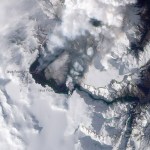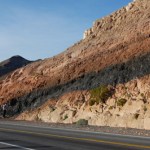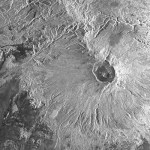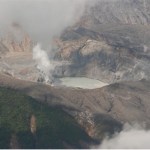
Busy busy today, so just a brief update on the ongoing Fimmvörðuháls/Eyjafjallajokull eruption in Iceland.
The coalesced vent of the Fimmvörðuháls fissure eruption in late March 2010.
The eruption is still going, albeit potentially with a little less vigor than before - and you can watch it on the Vodafone webcam, along with these other webcams from Mila.is. Haraldur Sigurdsson says that the eruption may have peaked (Icelandic) and is ~25% less vigorous than it was a few days ago, but this could change without notice. A fairly significant, long, low scoria cone has formed and lava flows…
Alright, I'm actually in Wisconsin right now for a wedding, but this was too cool to pass up ... the folks from the NASA Earth Observatory sent me this image (Natural-color, 10m/pixel) from the Advanced Land Imager aboard EO-1 of the Eyjafjallajokull-Fimmvörduháls eruption, both taken on March 24, 2010.
The Fimmvörduháls eruption in Iceland, taken March 24, 2010. Image courtesy of the NASA Earth Observatory. Click on the image for a larger version.
You can clearly see the flow heading down the drainage to the east, slowly snaking down the snow covered area. I think the steam plume on far…
Alan Boyle, Science Editor for MSNBC.com, was kind enough to answer questions about science in the mainstream media after the fallout of the coverage of the Chilean earthquake.
Alan Boyle, science editor for MSNBC.com
Alan has been with MSNBC.com since 1996, covering science and technology. He has his own blog on space called the Cosmic Log. He's also won quite the array of awards including from the National Academies, the American Association for the Advancement of Science, the National Association of Science Writers, the Society of Professional Journalists, the Space Frontier Foundation,…
I'm still playing catch-up after my week in the desert, so I've seen a lot of articles I've wanted to mention ... but a certain other volcano has taken up a lot of my time. However, I will attempt to make amends for that now.
By the way, would you believe Ubehebe Crater was closed? How do they close a volcano, anyway? However, I did get a great snap of a welded tuff on the road outside of Shoshone, CA.
A strongly welded tuff near Shoshone, CA. The dark interior is remelted volcanic ash/tephra surrounded by less welded pink tuff with abundant pumice clasts. Denison student David Sisak is on…
The fissure vent eruption near Eyjafjallajokull in Iceland. Image by Ãorsteinn Gunnarsson, March 22, 2010.
It has been hard to keep up with the flood of news from the Eyjafjallajokull eruption in Iceland. Eruptions readers have done a good job with getting new images, videos and info up as they happen, so you might want to peruse the comments for those sorts of tidbits (along with discussion of what might be happening).
Here is the latest:
The eruption at Fimmvörduháls (considering the eruption is actually occurring between the ice caps) could last weeks to months, which isn't too…
The steam-and-ash plume from Eyjafjallajokull in Iceland, March 22, 2010.
Overnight, the Eyjafjallajokull eruption in Iceland added to its oeuvre, producing what is being reported to be a 8-km plume. Images of the plume (above) suggest (to me) that it is very water-rich, so likely this is the expanding(?) fissure interacting with snow, ice or groundwater, producing steam explosions. These explosions have some minor ash component to them, mostly from the shattering of rapidly cooled lava, but are dominated by steam.
The eruption appears to be continuing into its third day unabated. Flights…
The fissure vent eruption on Eyjafjallajokull in Iceland on March 21, 2010.
The big news this morning is the eruption that started last night at Eyjafjallajokull in Iceland, producing a 1-km fissure vent. The pictures and videos I've seen so far have been quite impressive, with the classic look of a "curtain of fire", where basaltic lava erupts explosively from a linear array of vents - you can see the geometry in the image from the BBC/AP (above). Especially clear is the dual nature of the eruption, with both the explosive fire fountains and the effusive (passive) lava flows from the root of…
A shot from the Hekla webcam showing the glow from the eruption of Eyjafjallajökull that started March 20, 2010.
Quick note, but for those of you who have been following the seismicity at Eyjafjallajökull in Iceland, there is news from Iceland that an eruption has started. I will post more details as I can find them, but so far, evacuations have commenced near the volcano. It sounds like the eruption can be seen coming through the glacier on the volcano, but any real details of the style of volcanism are unknown. This is the first known eruption of Eyjafjallajökull since 1823.
UPDATE 9:40…
Cast your ballot for the next Volcano Profile!
Which volcano should be the next Volcano Profile?opinion
It has been a while since I've posted a Mystery Volcano Photo, but here is a new one. Just a refresher on the current standings:
The Bobs - 3
Don Crain - 3
gijs - 2
Boris Behncke - 2
volcanista - 1
Lockwood - 1
Elizabeth - 1
Ralph - 1
Anne - 1
Cam - 1
gg - 1
Damon Hynes - 1
Marco - 1
Doug C. - 1
Diane - 1
So, here is the new one ... take your best guess (but I'm sure someone will get it much faster than I would imagine) ... Good luck!
The latest in my Volcano Profiles series, this one on Erta Ale in Ethiopia.
The summit crater at Erta Ale in 1994
Location: The Afar region of Ethiopia.
Height: 613 m / 2,011 feetTectonic setting: Erta Ale (meaning "smoking mountain") is part of the East African Rift, where the African Continent is tearing apart along a seam that runs from the Red Sea/Gulf of Aden (two other arms of the rift themselves) south through eastern Africa. Many of the large lakes of eastern Africa such as Lakes Albert, Tanganyika, Nyasa and Kariba fill rift valleys created by the cracking of the continental plate…
Big volcano news while I'm away in Death Valley? Post it here - or just discuss all the volcanic bits that you run across ...
Moonrise over Ubehebe Crater, California.
Leaving for Death Valley tomorrow - I'll be sure to take some pictures of Ubehebe Crater and the volcano at the Mirage. This will likely be the last new post until about a week from now, but look for the Erta'Ale Volcano Profile, maybe a new Mystery Volcano Photo and I'll leave a thread open for any new volcano news.
Colima in Mexico.
Eruptions reader Tim Stone sent me this image from Japanese astronaut Soichi Noguchi's Twitpic feed - it is a stunner of the caldera on Jebel Marra in Sudan. The only known historical eruption for this volcano was ~2000 BC within the Deriba Caldera, but it has…
Did I mention its a busy week?
The lava lake at Erta'Ale in 2008. Image courtesy of Stromboli Online.
Our Icelandic saga continues, with more earthquakes and more speculation/information on the parts of Eruptions readers. Keep up the discussion - I'll be fascinated to see who turns out to get closest to what actually happens, prediction-wise. The seismicity has quieted somewhat again in the last 12 hours, so we wait eagerly to see what comes next. Remember, Iceland is the land where volcanoes helped change history, so it is always fun to talk Icelandic volcanism.
The NASA Earth Observatory…
Cleaning up some news ... busy week leading up to a field trip I am helping co-lead to Death Valley next week.
Ubehebe Crater in Death Valley, California
First off, I want to say how amazed I am at the great discussion that went on all weekend about the signs of potential activity in Iceland. It now appears that the earthquakes at Eyjafjallajökull may be waning, however the levels of seismicity have definitely bounced up and down over the last few days. However, the level and depth of the conversation is a testament to all volcanophiles out there. Nice job, folks.
For those of you into…
Mt. Baker in the northern Cascades of Washington.
One of the best websites dedicated to any volcano is the Mt. Baker Volcano Research Center - hosted by Western Washington University. I've talked about it before, but David Tucker and his associates have put together an excellent resource on this (at least in my opinion) woefully underappreciated Cascade volcano.
There is a pile of news from the MBVRC and I thought I'd pass it along.
First off, the 2010 T-shirt design contest has kicked off. Last year the MBVRC raised much needed funds with a T-shirt sale and now you can try to design the…
As many Eruptions readers read, the headlines produced by MSNBC for their coverage of the recent Chilean earthquake raised my ire. To me, it represented the sensationalism of the events - but as with all things media-related, there is a lot of opinions on the matter.
We were lucky to have Alan Boyle, science editor for MSNBC.com, comment on the fray and he has very kindly offered to take your questions about the coverage of science in the mainstream media. This is a unique opportunity for us to discuss how science is portrayed, the rationale for headlines and generally find out about how the…
Eyjafjallajökull, an ice-capped volcano in Iceland that last erupted in 1823.
We talked a few weeks ago of signs that there were increasing signs that an eruption could occur on Iceland - increased seismicity on the Reykjanes Ridge suggested that magma might be on the move. Now, we have two pieces of evidence that we might see activity at Eyjafjallajökull, on the southern side of the island nation.
First off, there is a focus of seismicity under the area of Eyjafjallajökull, with an especially large bump in the last 2 days. Both the number and magnitude of the seismicity has been marching…
Some news for a busy Tuesday:
The crater at Poas volcano in Costa Rica, taken February 25, 2010. Image courtesy of OVSICORI by Federico Chavarria.
After the MSNBC debacle, it is nice to see some good articles on why the Chilean earthquake was overall less disastrous than the Haitian earthquake, why the tsunami wasn't as large as predicted and why these earthquakes are not abnormal. There are a lot of factors involved - the location, depth, preparedness, wealth - so the comparison can be very telling in terms of both geologic and societal issues.
The other scientific fallout from the Chilean…
News!
Toba caldera in Indonesia.
We're all still talking about the Chilean earthquake and the coverage of the event. If you happen to live in the Columbus area, you might have heard me on WTVN talking about the earthquake as well.
The Toba (Indonesia) eruption 74,000 years ago has been used by some researchers to be the cause of a "genetic bottleneck" for humans - however, that is still much debated. Currently, excavations are under away near Toba to look for evidence of human habitation that was buried by the eruption. The evidence of stone tools that appear to be made by the same human…



